Accounting Theory, Contemporary Issues, and Financial Reporting at CSR
VerifiedAdded on 2023/06/15
|16
|3129
|319
Report
AI Summary
This report provides a detailed analysis of accounting theory and contemporary issues, focusing on CSR Building Products, an ASX-listed company in Australia. It examines the company's adherence to the conceptual framework, compliance with Australian Accounting Standards (AASB) and International Financial Reporting Standards (IFRS), and the preparation of general-purpose financial reports. The report delves into specific areas such as remuneration reporting, inventory valuation, accounts receivable, plant, property, and equipment (PPE), liabilities, intangible assets, leases, and taxation. It also addresses issues related to environmental rehabilitation, legal claims, and the application of prudence in financial reporting. The analysis includes a review of CSR's financial statements, directors' reports, and remuneration reports, with comparisons between the financial years 2015 and 2016. The report concludes by emphasizing the importance of prudence in accounting practices and the impact of new accounting standards, such as AASB 16, on the company's financial performance.
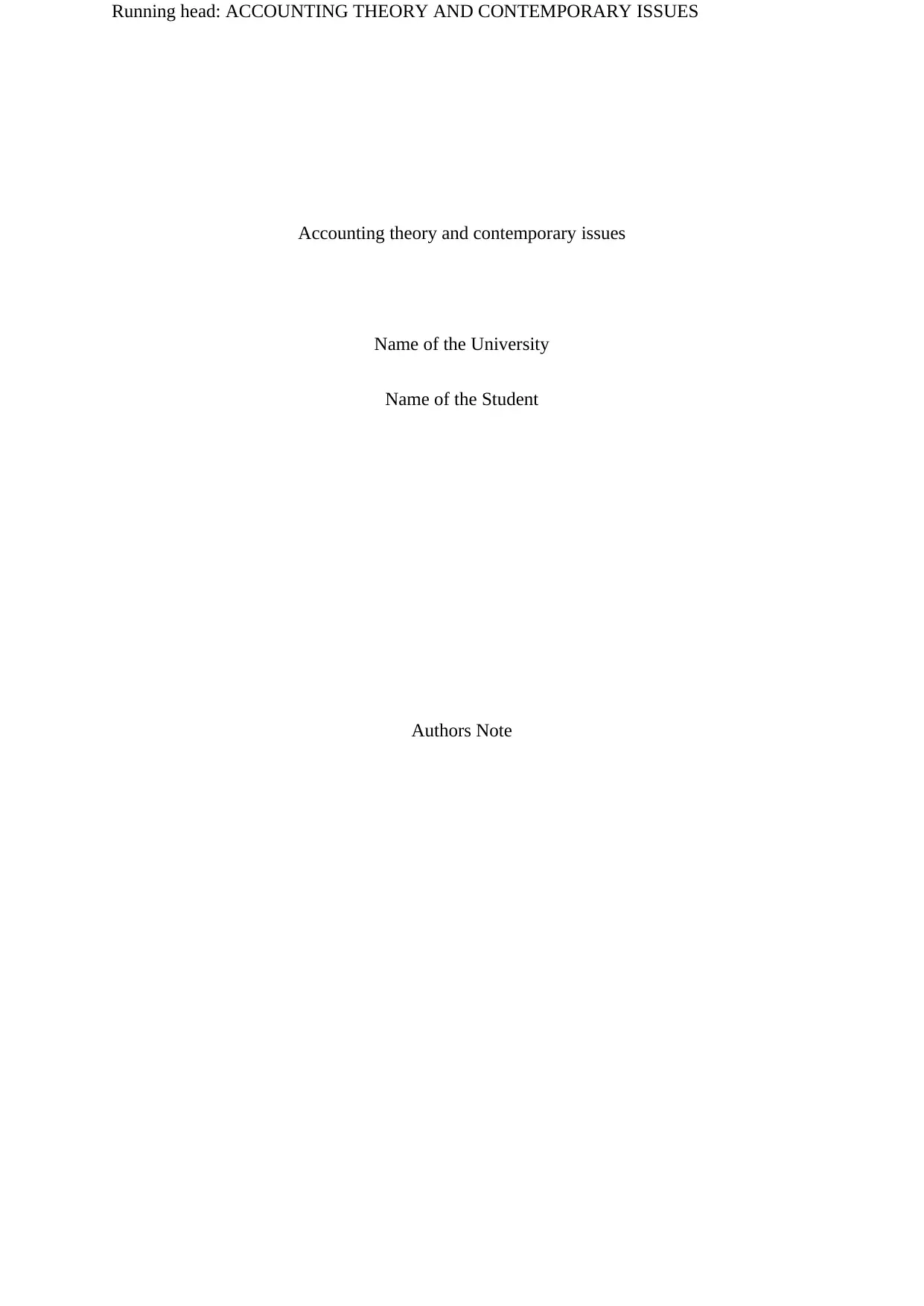
Running head: ACCOUNTING THEORY AND CONTEMPORARY ISSUES
Accounting theory and contemporary issues
Name of the University
Name of the Student
Authors Note
Accounting theory and contemporary issues
Name of the University
Name of the Student
Authors Note
Paraphrase This Document
Need a fresh take? Get an instant paraphrase of this document with our AI Paraphraser
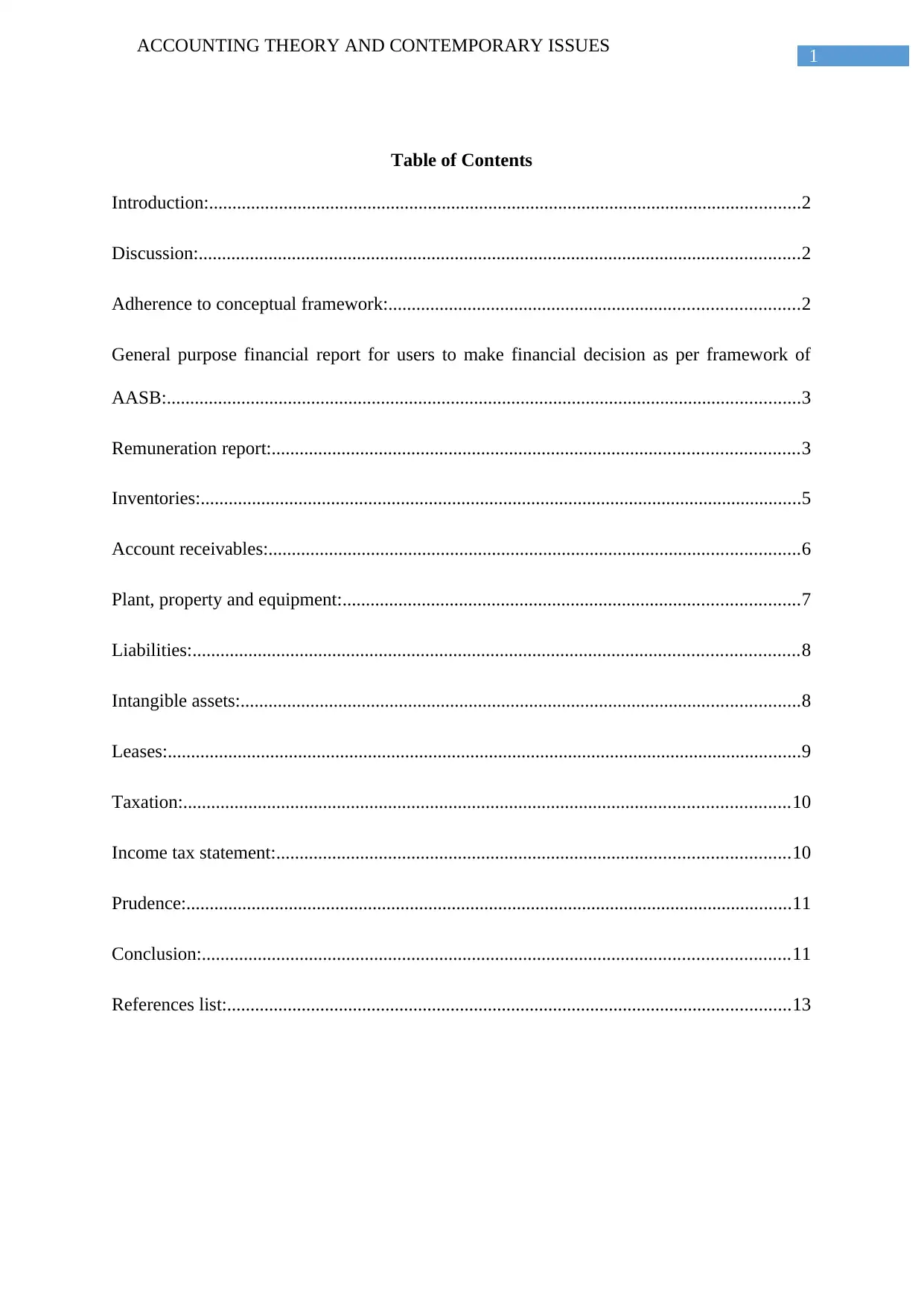
1
ACCOUNTING THEORY AND CONTEMPORARY ISSUES
Table of Contents
Introduction:...............................................................................................................................2
Discussion:.................................................................................................................................2
Adherence to conceptual framework:........................................................................................2
General purpose financial report for users to make financial decision as per framework of
AASB:........................................................................................................................................3
Remuneration report:.................................................................................................................3
Inventories:.................................................................................................................................5
Account receivables:..................................................................................................................6
Plant, property and equipment:..................................................................................................7
Liabilities:..................................................................................................................................8
Intangible assets:........................................................................................................................8
Leases:........................................................................................................................................9
Taxation:..................................................................................................................................10
Income tax statement:..............................................................................................................10
Prudence:..................................................................................................................................11
Conclusion:..............................................................................................................................11
References list:.........................................................................................................................13
ACCOUNTING THEORY AND CONTEMPORARY ISSUES
Table of Contents
Introduction:...............................................................................................................................2
Discussion:.................................................................................................................................2
Adherence to conceptual framework:........................................................................................2
General purpose financial report for users to make financial decision as per framework of
AASB:........................................................................................................................................3
Remuneration report:.................................................................................................................3
Inventories:.................................................................................................................................5
Account receivables:..................................................................................................................6
Plant, property and equipment:..................................................................................................7
Liabilities:..................................................................................................................................8
Intangible assets:........................................................................................................................8
Leases:........................................................................................................................................9
Taxation:..................................................................................................................................10
Income tax statement:..............................................................................................................10
Prudence:..................................................................................................................................11
Conclusion:..............................................................................................................................11
References list:.........................................................................................................................13
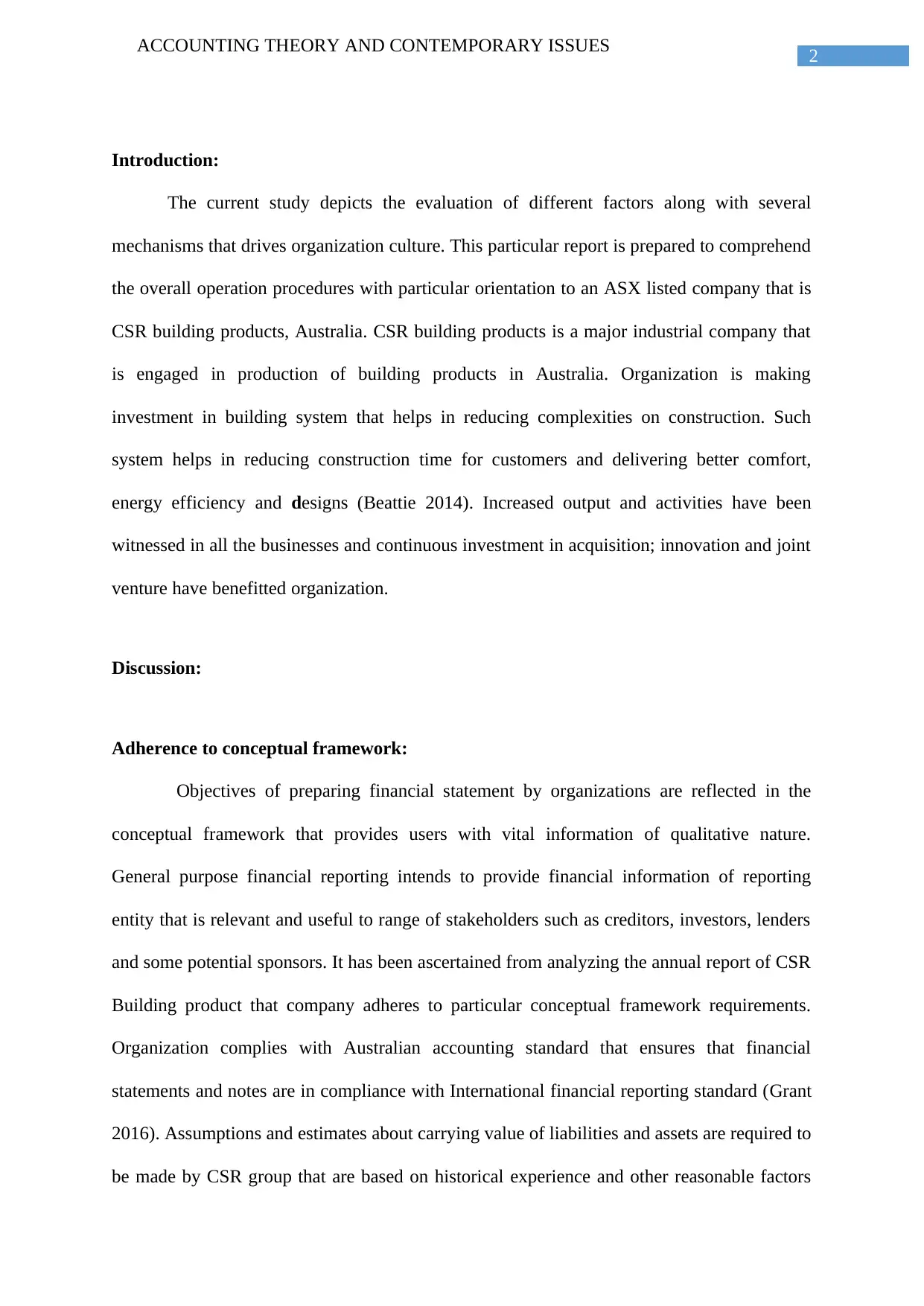
2
ACCOUNTING THEORY AND CONTEMPORARY ISSUES
Introduction:
The current study depicts the evaluation of different factors along with several
mechanisms that drives organization culture. This particular report is prepared to comprehend
the overall operation procedures with particular orientation to an ASX listed company that is
CSR building products, Australia. CSR building products is a major industrial company that
is engaged in production of building products in Australia. Organization is making
investment in building system that helps in reducing complexities on construction. Such
system helps in reducing construction time for customers and delivering better comfort,
energy efficiency and designs (Beattie 2014). Increased output and activities have been
witnessed in all the businesses and continuous investment in acquisition; innovation and joint
venture have benefitted organization.
Discussion:
Adherence to conceptual framework:
Objectives of preparing financial statement by organizations are reflected in the
conceptual framework that provides users with vital information of qualitative nature.
General purpose financial reporting intends to provide financial information of reporting
entity that is relevant and useful to range of stakeholders such as creditors, investors, lenders
and some potential sponsors. It has been ascertained from analyzing the annual report of CSR
Building product that company adheres to particular conceptual framework requirements.
Organization complies with Australian accounting standard that ensures that financial
statements and notes are in compliance with International financial reporting standard (Grant
2016). Assumptions and estimates about carrying value of liabilities and assets are required to
be made by CSR group that are based on historical experience and other reasonable factors
ACCOUNTING THEORY AND CONTEMPORARY ISSUES
Introduction:
The current study depicts the evaluation of different factors along with several
mechanisms that drives organization culture. This particular report is prepared to comprehend
the overall operation procedures with particular orientation to an ASX listed company that is
CSR building products, Australia. CSR building products is a major industrial company that
is engaged in production of building products in Australia. Organization is making
investment in building system that helps in reducing complexities on construction. Such
system helps in reducing construction time for customers and delivering better comfort,
energy efficiency and designs (Beattie 2014). Increased output and activities have been
witnessed in all the businesses and continuous investment in acquisition; innovation and joint
venture have benefitted organization.
Discussion:
Adherence to conceptual framework:
Objectives of preparing financial statement by organizations are reflected in the
conceptual framework that provides users with vital information of qualitative nature.
General purpose financial reporting intends to provide financial information of reporting
entity that is relevant and useful to range of stakeholders such as creditors, investors, lenders
and some potential sponsors. It has been ascertained from analyzing the annual report of CSR
Building product that company adheres to particular conceptual framework requirements.
Organization complies with Australian accounting standard that ensures that financial
statements and notes are in compliance with International financial reporting standard (Grant
2016). Assumptions and estimates about carrying value of liabilities and assets are required to
be made by CSR group that are based on historical experience and other reasonable factors
⊘ This is a preview!⊘
Do you want full access?
Subscribe today to unlock all pages.

Trusted by 1+ million students worldwide
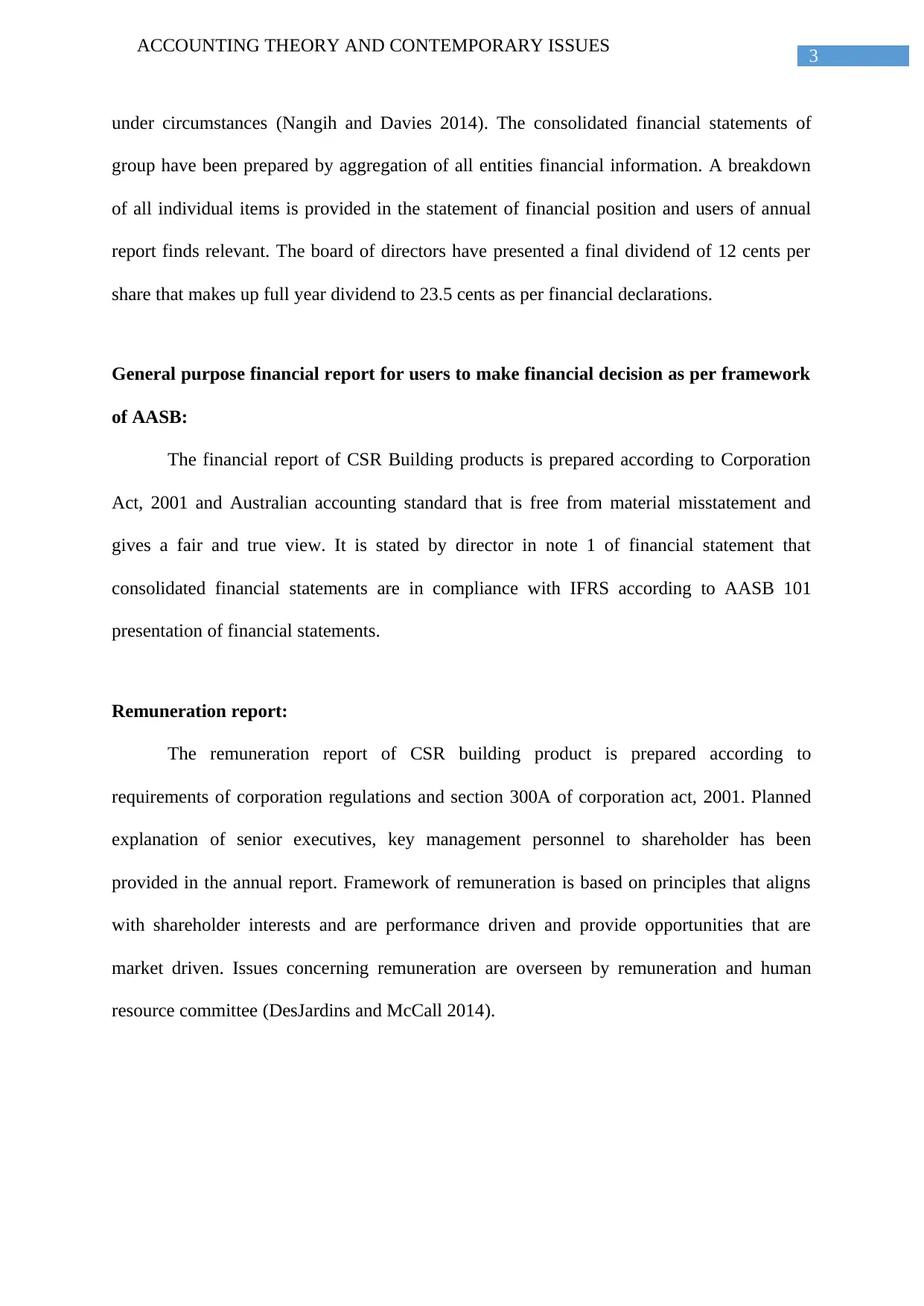
3
ACCOUNTING THEORY AND CONTEMPORARY ISSUES
under circumstances (Nangih and Davies 2014). The consolidated financial statements of
group have been prepared by aggregation of all entities financial information. A breakdown
of all individual items is provided in the statement of financial position and users of annual
report finds relevant. The board of directors have presented a final dividend of 12 cents per
share that makes up full year dividend to 23.5 cents as per financial declarations.
General purpose financial report for users to make financial decision as per framework
of AASB:
The financial report of CSR Building products is prepared according to Corporation
Act, 2001 and Australian accounting standard that is free from material misstatement and
gives a fair and true view. It is stated by director in note 1 of financial statement that
consolidated financial statements are in compliance with IFRS according to AASB 101
presentation of financial statements.
Remuneration report:
The remuneration report of CSR building product is prepared according to
requirements of corporation regulations and section 300A of corporation act, 2001. Planned
explanation of senior executives, key management personnel to shareholder has been
provided in the annual report. Framework of remuneration is based on principles that aligns
with shareholder interests and are performance driven and provide opportunities that are
market driven. Issues concerning remuneration are overseen by remuneration and human
resource committee (DesJardins and McCall 2014).
ACCOUNTING THEORY AND CONTEMPORARY ISSUES
under circumstances (Nangih and Davies 2014). The consolidated financial statements of
group have been prepared by aggregation of all entities financial information. A breakdown
of all individual items is provided in the statement of financial position and users of annual
report finds relevant. The board of directors have presented a final dividend of 12 cents per
share that makes up full year dividend to 23.5 cents as per financial declarations.
General purpose financial report for users to make financial decision as per framework
of AASB:
The financial report of CSR Building products is prepared according to Corporation
Act, 2001 and Australian accounting standard that is free from material misstatement and
gives a fair and true view. It is stated by director in note 1 of financial statement that
consolidated financial statements are in compliance with IFRS according to AASB 101
presentation of financial statements.
Remuneration report:
The remuneration report of CSR building product is prepared according to
requirements of corporation regulations and section 300A of corporation act, 2001. Planned
explanation of senior executives, key management personnel to shareholder has been
provided in the annual report. Framework of remuneration is based on principles that aligns
with shareholder interests and are performance driven and provide opportunities that are
market driven. Issues concerning remuneration are overseen by remuneration and human
resource committee (DesJardins and McCall 2014).
Paraphrase This Document
Need a fresh take? Get an instant paraphrase of this document with our AI Paraphraser
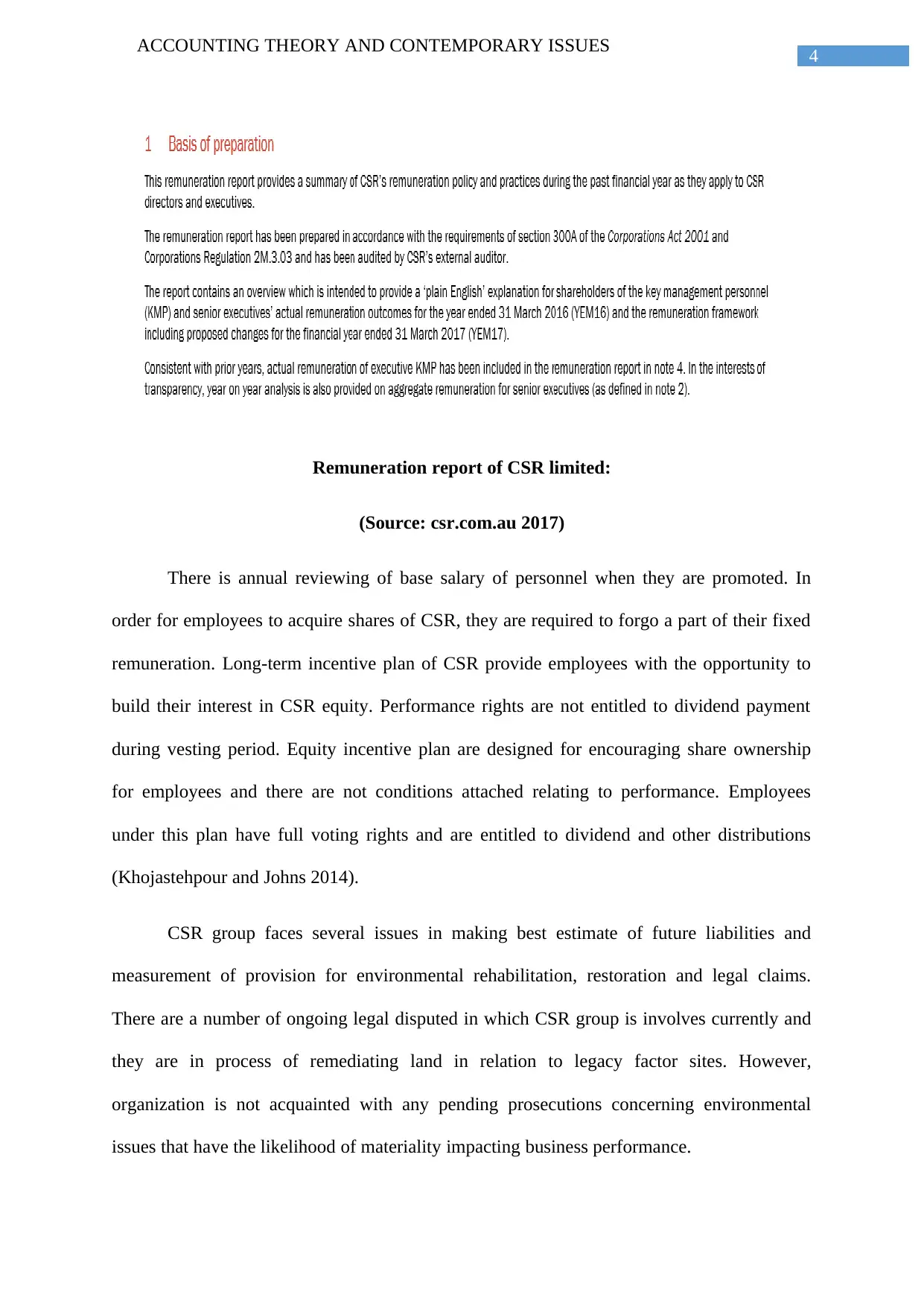
4
ACCOUNTING THEORY AND CONTEMPORARY ISSUES
Remuneration report of CSR limited:
(Source: csr.com.au 2017)
There is annual reviewing of base salary of personnel when they are promoted. In
order for employees to acquire shares of CSR, they are required to forgo a part of their fixed
remuneration. Long-term incentive plan of CSR provide employees with the opportunity to
build their interest in CSR equity. Performance rights are not entitled to dividend payment
during vesting period. Equity incentive plan are designed for encouraging share ownership
for employees and there are not conditions attached relating to performance. Employees
under this plan have full voting rights and are entitled to dividend and other distributions
(Khojastehpour and Johns 2014).
CSR group faces several issues in making best estimate of future liabilities and
measurement of provision for environmental rehabilitation, restoration and legal claims.
There are a number of ongoing legal disputed in which CSR group is involves currently and
they are in process of remediating land in relation to legacy factor sites. However,
organization is not acquainted with any pending prosecutions concerning environmental
issues that have the likelihood of materiality impacting business performance.
ACCOUNTING THEORY AND CONTEMPORARY ISSUES
Remuneration report of CSR limited:
(Source: csr.com.au 2017)
There is annual reviewing of base salary of personnel when they are promoted. In
order for employees to acquire shares of CSR, they are required to forgo a part of their fixed
remuneration. Long-term incentive plan of CSR provide employees with the opportunity to
build their interest in CSR equity. Performance rights are not entitled to dividend payment
during vesting period. Equity incentive plan are designed for encouraging share ownership
for employees and there are not conditions attached relating to performance. Employees
under this plan have full voting rights and are entitled to dividend and other distributions
(Khojastehpour and Johns 2014).
CSR group faces several issues in making best estimate of future liabilities and
measurement of provision for environmental rehabilitation, restoration and legal claims.
There are a number of ongoing legal disputed in which CSR group is involves currently and
they are in process of remediating land in relation to legacy factor sites. However,
organization is not acquainted with any pending prosecutions concerning environmental
issues that have the likelihood of materiality impacting business performance.
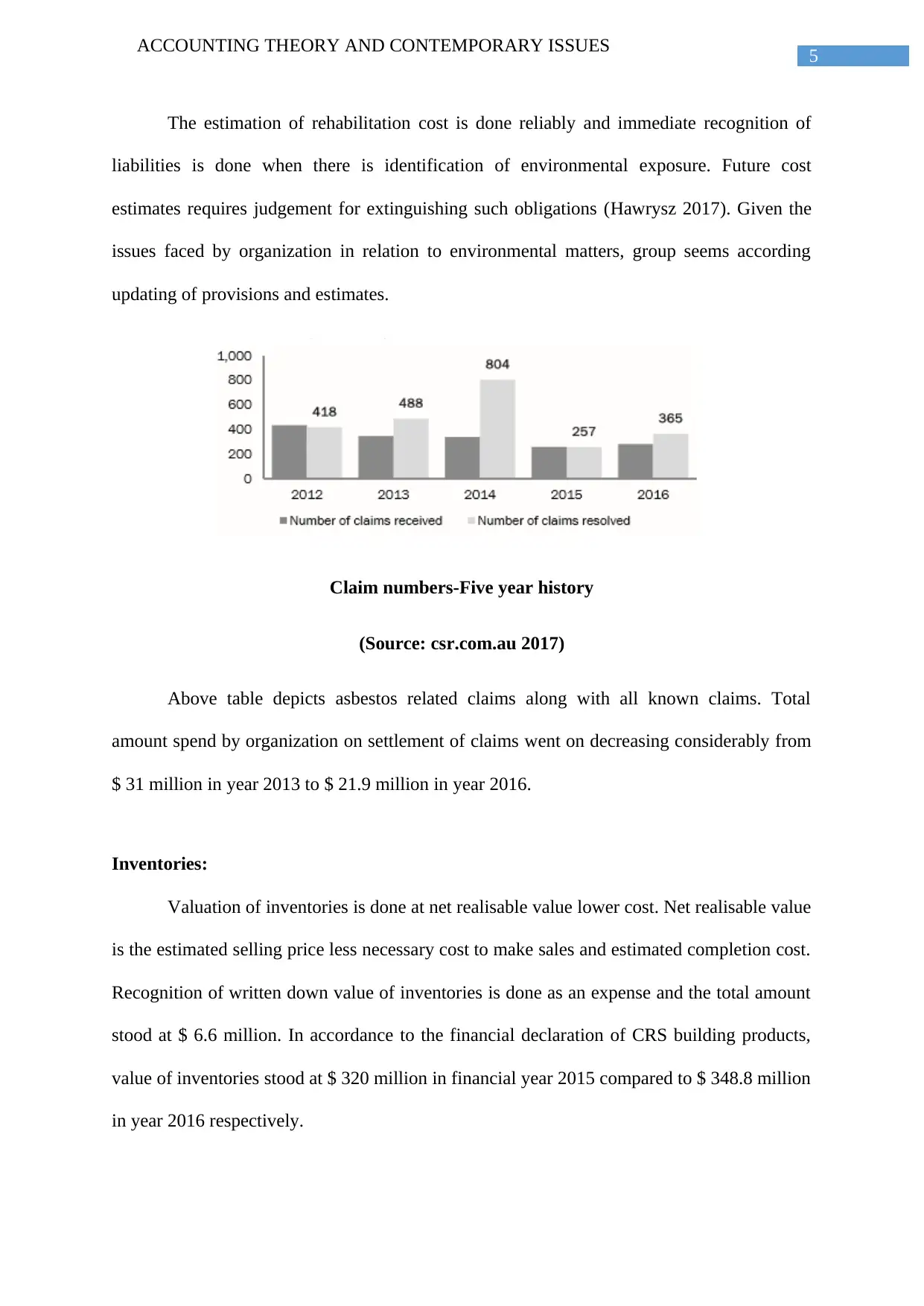
5
ACCOUNTING THEORY AND CONTEMPORARY ISSUES
The estimation of rehabilitation cost is done reliably and immediate recognition of
liabilities is done when there is identification of environmental exposure. Future cost
estimates requires judgement for extinguishing such obligations (Hawrysz 2017). Given the
issues faced by organization in relation to environmental matters, group seems according
updating of provisions and estimates.
Claim numbers-Five year history
(Source: csr.com.au 2017)
Above table depicts asbestos related claims along with all known claims. Total
amount spend by organization on settlement of claims went on decreasing considerably from
$ 31 million in year 2013 to $ 21.9 million in year 2016.
Inventories:
Valuation of inventories is done at net realisable value lower cost. Net realisable value
is the estimated selling price less necessary cost to make sales and estimated completion cost.
Recognition of written down value of inventories is done as an expense and the total amount
stood at $ 6.6 million. In accordance to the financial declaration of CRS building products,
value of inventories stood at $ 320 million in financial year 2015 compared to $ 348.8 million
in year 2016 respectively.
ACCOUNTING THEORY AND CONTEMPORARY ISSUES
The estimation of rehabilitation cost is done reliably and immediate recognition of
liabilities is done when there is identification of environmental exposure. Future cost
estimates requires judgement for extinguishing such obligations (Hawrysz 2017). Given the
issues faced by organization in relation to environmental matters, group seems according
updating of provisions and estimates.
Claim numbers-Five year history
(Source: csr.com.au 2017)
Above table depicts asbestos related claims along with all known claims. Total
amount spend by organization on settlement of claims went on decreasing considerably from
$ 31 million in year 2013 to $ 21.9 million in year 2016.
Inventories:
Valuation of inventories is done at net realisable value lower cost. Net realisable value
is the estimated selling price less necessary cost to make sales and estimated completion cost.
Recognition of written down value of inventories is done as an expense and the total amount
stood at $ 6.6 million. In accordance to the financial declaration of CRS building products,
value of inventories stood at $ 320 million in financial year 2015 compared to $ 348.8 million
in year 2016 respectively.
⊘ This is a preview!⊘
Do you want full access?
Subscribe today to unlock all pages.

Trusted by 1+ million students worldwide
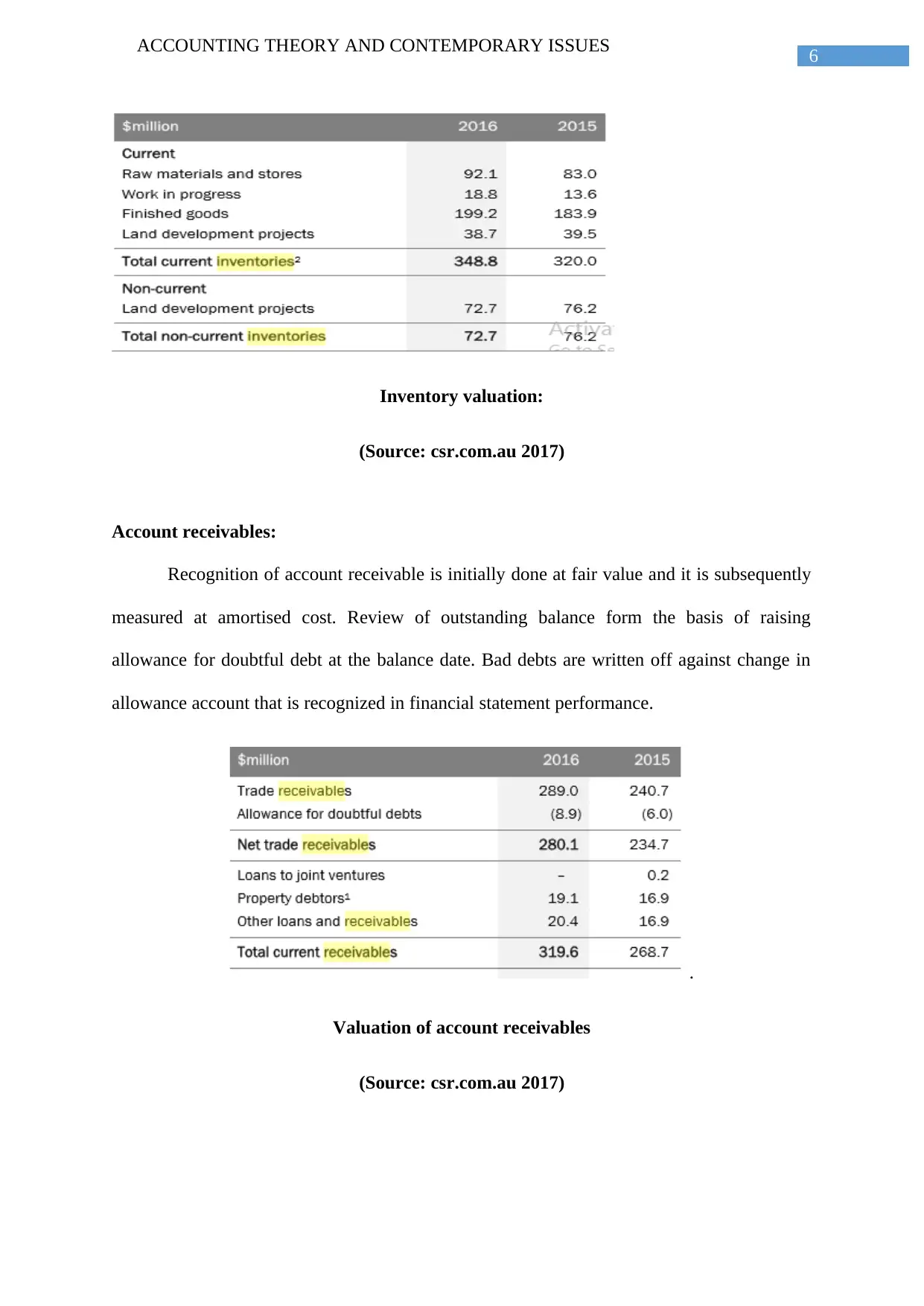
6
ACCOUNTING THEORY AND CONTEMPORARY ISSUES
Inventory valuation:
(Source: csr.com.au 2017)
Account receivables:
Recognition of account receivable is initially done at fair value and it is subsequently
measured at amortised cost. Review of outstanding balance form the basis of raising
allowance for doubtful debt at the balance date. Bad debts are written off against change in
allowance account that is recognized in financial statement performance.
.
Valuation of account receivables
(Source: csr.com.au 2017)
ACCOUNTING THEORY AND CONTEMPORARY ISSUES
Inventory valuation:
(Source: csr.com.au 2017)
Account receivables:
Recognition of account receivable is initially done at fair value and it is subsequently
measured at amortised cost. Review of outstanding balance form the basis of raising
allowance for doubtful debt at the balance date. Bad debts are written off against change in
allowance account that is recognized in financial statement performance.
.
Valuation of account receivables
(Source: csr.com.au 2017)
Paraphrase This Document
Need a fresh take? Get an instant paraphrase of this document with our AI Paraphraser
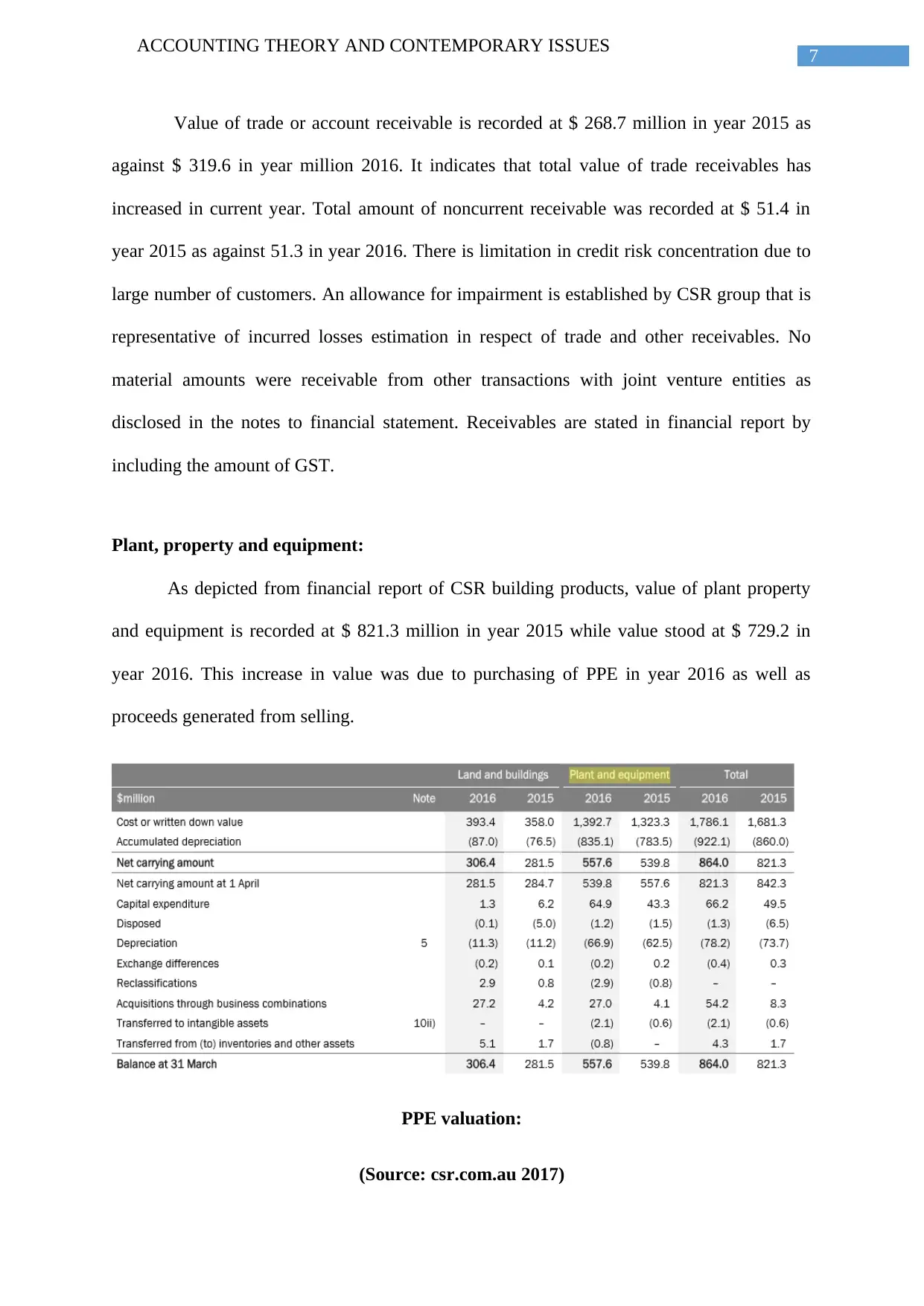
7
ACCOUNTING THEORY AND CONTEMPORARY ISSUES
Value of trade or account receivable is recorded at $ 268.7 million in year 2015 as
against $ 319.6 in year million 2016. It indicates that total value of trade receivables has
increased in current year. Total amount of noncurrent receivable was recorded at $ 51.4 in
year 2015 as against 51.3 in year 2016. There is limitation in credit risk concentration due to
large number of customers. An allowance for impairment is established by CSR group that is
representative of incurred losses estimation in respect of trade and other receivables. No
material amounts were receivable from other transactions with joint venture entities as
disclosed in the notes to financial statement. Receivables are stated in financial report by
including the amount of GST.
Plant, property and equipment:
As depicted from financial report of CSR building products, value of plant property
and equipment is recorded at $ 821.3 million in year 2015 while value stood at $ 729.2 in
year 2016. This increase in value was due to purchasing of PPE in year 2016 as well as
proceeds generated from selling.
PPE valuation:
(Source: csr.com.au 2017)
ACCOUNTING THEORY AND CONTEMPORARY ISSUES
Value of trade or account receivable is recorded at $ 268.7 million in year 2015 as
against $ 319.6 in year million 2016. It indicates that total value of trade receivables has
increased in current year. Total amount of noncurrent receivable was recorded at $ 51.4 in
year 2015 as against 51.3 in year 2016. There is limitation in credit risk concentration due to
large number of customers. An allowance for impairment is established by CSR group that is
representative of incurred losses estimation in respect of trade and other receivables. No
material amounts were receivable from other transactions with joint venture entities as
disclosed in the notes to financial statement. Receivables are stated in financial report by
including the amount of GST.
Plant, property and equipment:
As depicted from financial report of CSR building products, value of plant property
and equipment is recorded at $ 821.3 million in year 2015 while value stood at $ 729.2 in
year 2016. This increase in value was due to purchasing of PPE in year 2016 as well as
proceeds generated from selling.
PPE valuation:
(Source: csr.com.au 2017)
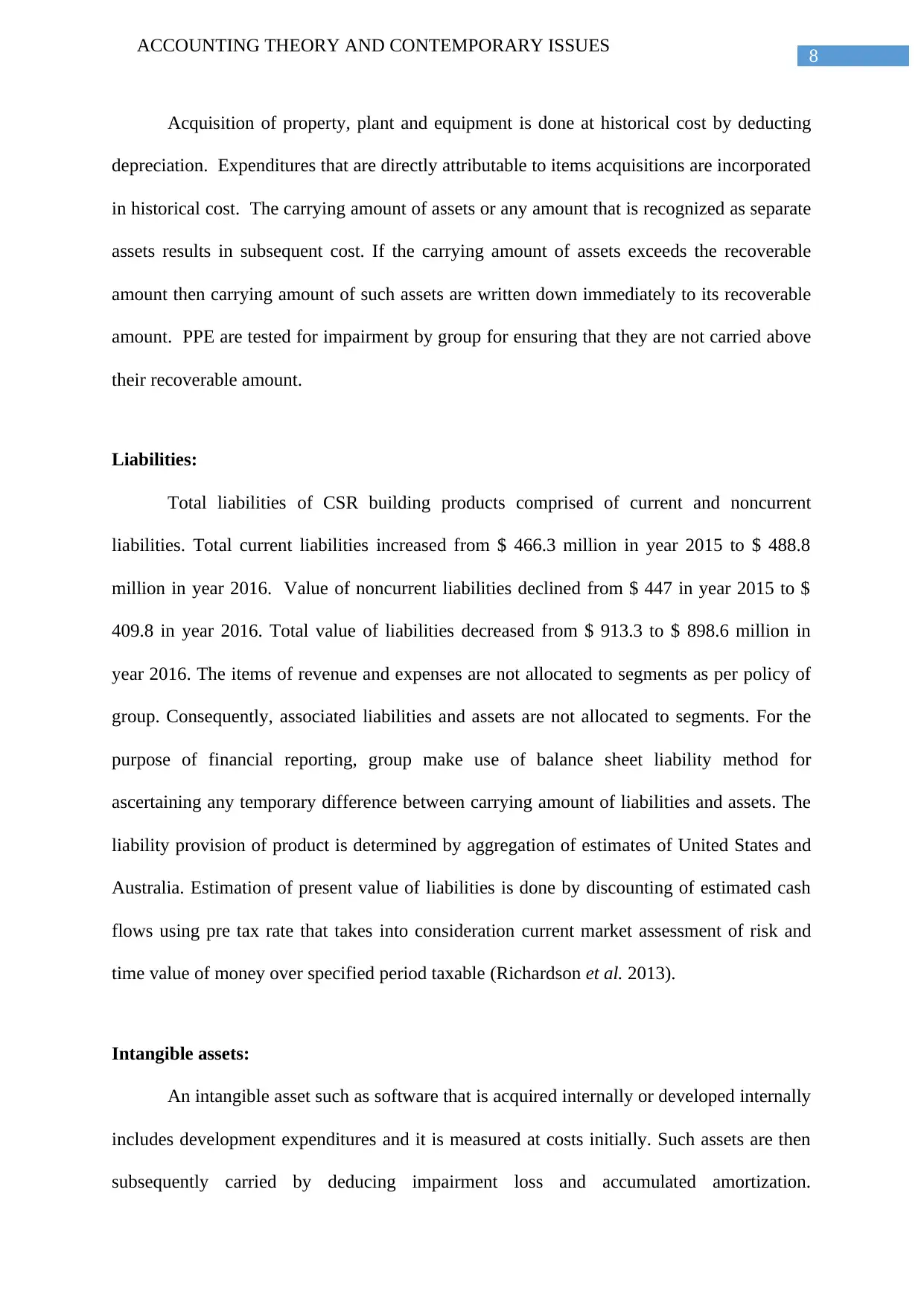
8
ACCOUNTING THEORY AND CONTEMPORARY ISSUES
Acquisition of property, plant and equipment is done at historical cost by deducting
depreciation. Expenditures that are directly attributable to items acquisitions are incorporated
in historical cost. The carrying amount of assets or any amount that is recognized as separate
assets results in subsequent cost. If the carrying amount of assets exceeds the recoverable
amount then carrying amount of such assets are written down immediately to its recoverable
amount. PPE are tested for impairment by group for ensuring that they are not carried above
their recoverable amount.
Liabilities:
Total liabilities of CSR building products comprised of current and noncurrent
liabilities. Total current liabilities increased from $ 466.3 million in year 2015 to $ 488.8
million in year 2016. Value of noncurrent liabilities declined from $ 447 in year 2015 to $
409.8 in year 2016. Total value of liabilities decreased from $ 913.3 to $ 898.6 million in
year 2016. The items of revenue and expenses are not allocated to segments as per policy of
group. Consequently, associated liabilities and assets are not allocated to segments. For the
purpose of financial reporting, group make use of balance sheet liability method for
ascertaining any temporary difference between carrying amount of liabilities and assets. The
liability provision of product is determined by aggregation of estimates of United States and
Australia. Estimation of present value of liabilities is done by discounting of estimated cash
flows using pre tax rate that takes into consideration current market assessment of risk and
time value of money over specified period taxable (Richardson et al. 2013).
Intangible assets:
An intangible asset such as software that is acquired internally or developed internally
includes development expenditures and it is measured at costs initially. Such assets are then
subsequently carried by deducing impairment loss and accumulated amortization.
ACCOUNTING THEORY AND CONTEMPORARY ISSUES
Acquisition of property, plant and equipment is done at historical cost by deducting
depreciation. Expenditures that are directly attributable to items acquisitions are incorporated
in historical cost. The carrying amount of assets or any amount that is recognized as separate
assets results in subsequent cost. If the carrying amount of assets exceeds the recoverable
amount then carrying amount of such assets are written down immediately to its recoverable
amount. PPE are tested for impairment by group for ensuring that they are not carried above
their recoverable amount.
Liabilities:
Total liabilities of CSR building products comprised of current and noncurrent
liabilities. Total current liabilities increased from $ 466.3 million in year 2015 to $ 488.8
million in year 2016. Value of noncurrent liabilities declined from $ 447 in year 2015 to $
409.8 in year 2016. Total value of liabilities decreased from $ 913.3 to $ 898.6 million in
year 2016. The items of revenue and expenses are not allocated to segments as per policy of
group. Consequently, associated liabilities and assets are not allocated to segments. For the
purpose of financial reporting, group make use of balance sheet liability method for
ascertaining any temporary difference between carrying amount of liabilities and assets. The
liability provision of product is determined by aggregation of estimates of United States and
Australia. Estimation of present value of liabilities is done by discounting of estimated cash
flows using pre tax rate that takes into consideration current market assessment of risk and
time value of money over specified period taxable (Richardson et al. 2013).
Intangible assets:
An intangible asset such as software that is acquired internally or developed internally
includes development expenditures and it is measured at costs initially. Such assets are then
subsequently carried by deducing impairment loss and accumulated amortization.
⊘ This is a preview!⊘
Do you want full access?
Subscribe today to unlock all pages.

Trusted by 1+ million students worldwide
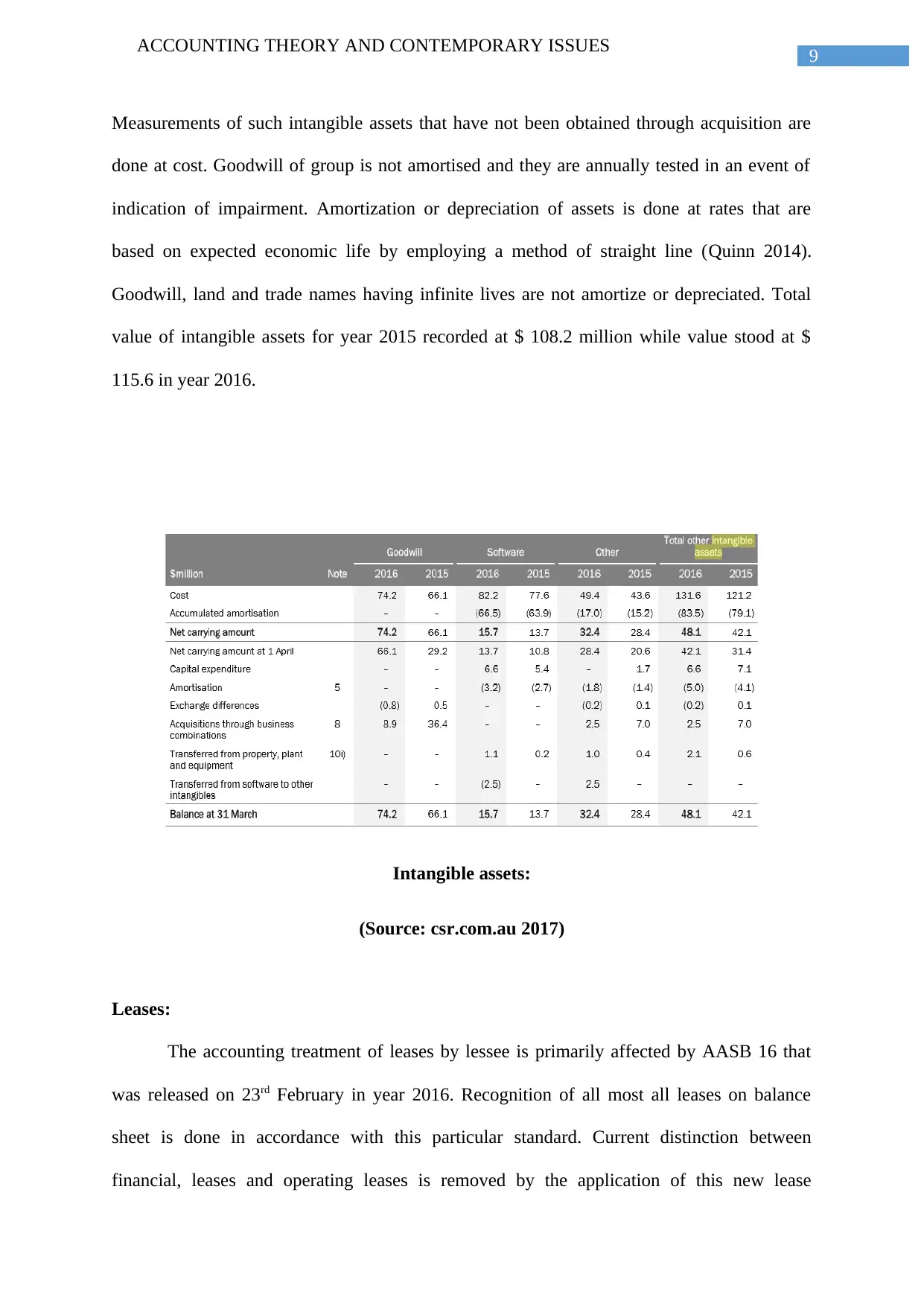
9
ACCOUNTING THEORY AND CONTEMPORARY ISSUES
Measurements of such intangible assets that have not been obtained through acquisition are
done at cost. Goodwill of group is not amortised and they are annually tested in an event of
indication of impairment. Amortization or depreciation of assets is done at rates that are
based on expected economic life by employing a method of straight line (Quinn 2014).
Goodwill, land and trade names having infinite lives are not amortize or depreciated. Total
value of intangible assets for year 2015 recorded at $ 108.2 million while value stood at $
115.6 in year 2016.
Intangible assets:
(Source: csr.com.au 2017)
Leases:
The accounting treatment of leases by lessee is primarily affected by AASB 16 that
was released on 23rd February in year 2016. Recognition of all most all leases on balance
sheet is done in accordance with this particular standard. Current distinction between
financial, leases and operating leases is removed by the application of this new lease
ACCOUNTING THEORY AND CONTEMPORARY ISSUES
Measurements of such intangible assets that have not been obtained through acquisition are
done at cost. Goodwill of group is not amortised and they are annually tested in an event of
indication of impairment. Amortization or depreciation of assets is done at rates that are
based on expected economic life by employing a method of straight line (Quinn 2014).
Goodwill, land and trade names having infinite lives are not amortize or depreciated. Total
value of intangible assets for year 2015 recorded at $ 108.2 million while value stood at $
115.6 in year 2016.
Intangible assets:
(Source: csr.com.au 2017)
Leases:
The accounting treatment of leases by lessee is primarily affected by AASB 16 that
was released on 23rd February in year 2016. Recognition of all most all leases on balance
sheet is done in accordance with this particular standard. Current distinction between
financial, leases and operating leases is removed by the application of this new lease
Paraphrase This Document
Need a fresh take? Get an instant paraphrase of this document with our AI Paraphraser
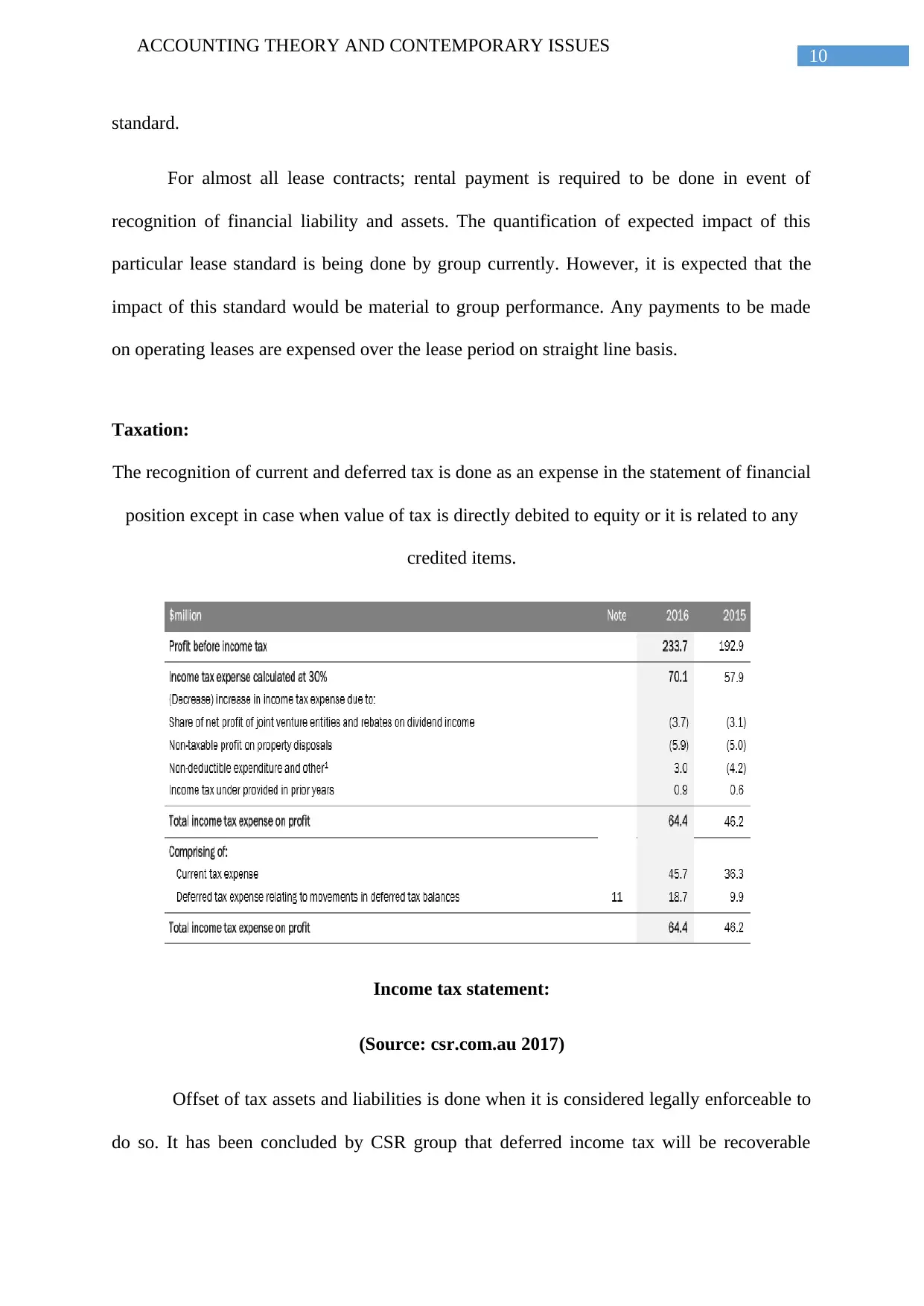
10
ACCOUNTING THEORY AND CONTEMPORARY ISSUES
standard.
For almost all lease contracts; rental payment is required to be done in event of
recognition of financial liability and assets. The quantification of expected impact of this
particular lease standard is being done by group currently. However, it is expected that the
impact of this standard would be material to group performance. Any payments to be made
on operating leases are expensed over the lease period on straight line basis.
Taxation:
The recognition of current and deferred tax is done as an expense in the statement of financial
position except in case when value of tax is directly debited to equity or it is related to any
credited items.
Income tax statement:
(Source: csr.com.au 2017)
Offset of tax assets and liabilities is done when it is considered legally enforceable to
do so. It has been concluded by CSR group that deferred income tax will be recoverable
ACCOUNTING THEORY AND CONTEMPORARY ISSUES
standard.
For almost all lease contracts; rental payment is required to be done in event of
recognition of financial liability and assets. The quantification of expected impact of this
particular lease standard is being done by group currently. However, it is expected that the
impact of this standard would be material to group performance. Any payments to be made
on operating leases are expensed over the lease period on straight line basis.
Taxation:
The recognition of current and deferred tax is done as an expense in the statement of financial
position except in case when value of tax is directly debited to equity or it is related to any
credited items.
Income tax statement:
(Source: csr.com.au 2017)
Offset of tax assets and liabilities is done when it is considered legally enforceable to
do so. It has been concluded by CSR group that deferred income tax will be recoverable
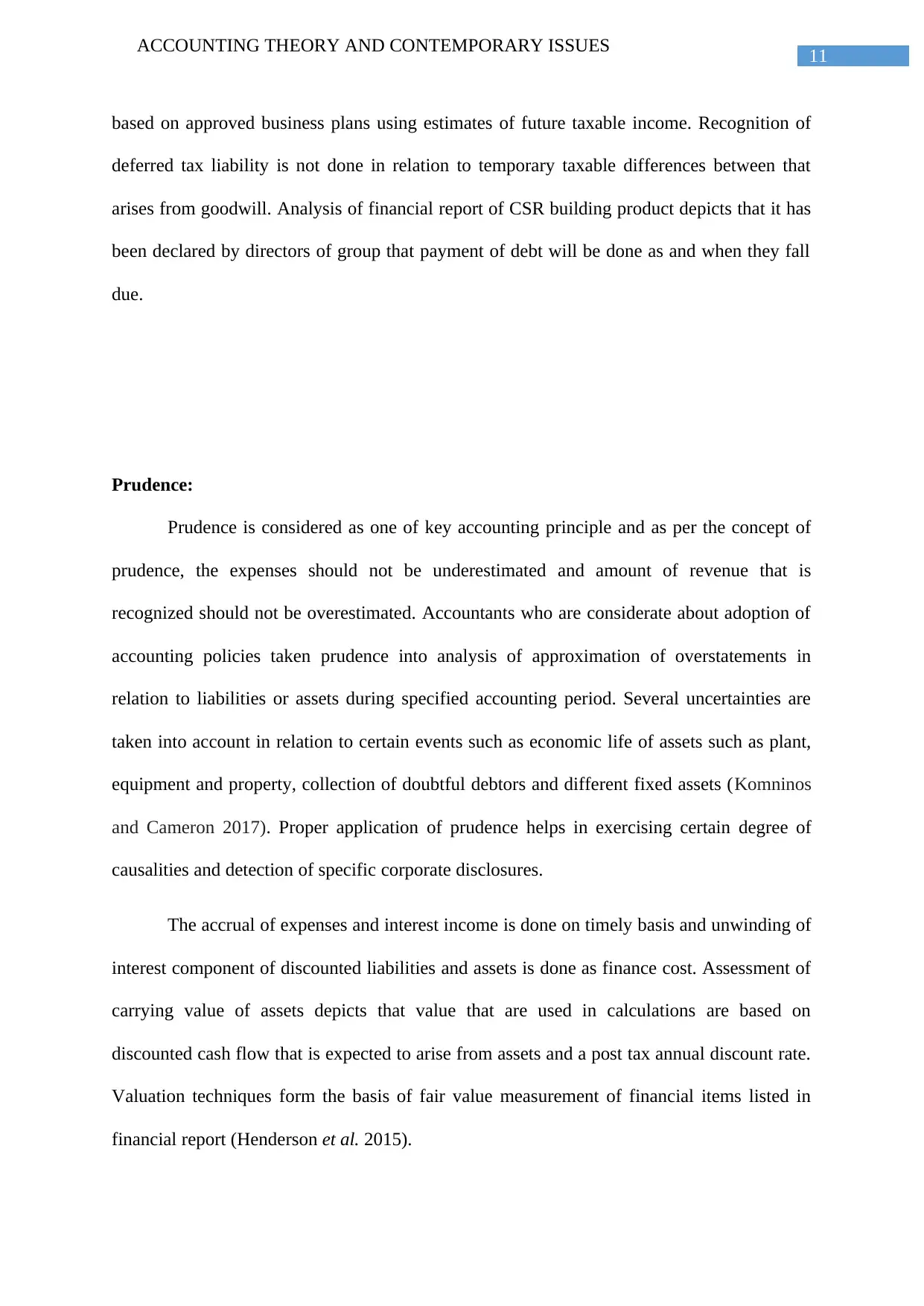
11
ACCOUNTING THEORY AND CONTEMPORARY ISSUES
based on approved business plans using estimates of future taxable income. Recognition of
deferred tax liability is not done in relation to temporary taxable differences between that
arises from goodwill. Analysis of financial report of CSR building product depicts that it has
been declared by directors of group that payment of debt will be done as and when they fall
due.
Prudence:
Prudence is considered as one of key accounting principle and as per the concept of
prudence, the expenses should not be underestimated and amount of revenue that is
recognized should not be overestimated. Accountants who are considerate about adoption of
accounting policies taken prudence into analysis of approximation of overstatements in
relation to liabilities or assets during specified accounting period. Several uncertainties are
taken into account in relation to certain events such as economic life of assets such as plant,
equipment and property, collection of doubtful debtors and different fixed assets (Komninos
and Cameron 2017). Proper application of prudence helps in exercising certain degree of
causalities and detection of specific corporate disclosures.
The accrual of expenses and interest income is done on timely basis and unwinding of
interest component of discounted liabilities and assets is done as finance cost. Assessment of
carrying value of assets depicts that value that are used in calculations are based on
discounted cash flow that is expected to arise from assets and a post tax annual discount rate.
Valuation techniques form the basis of fair value measurement of financial items listed in
financial report (Henderson et al. 2015).
ACCOUNTING THEORY AND CONTEMPORARY ISSUES
based on approved business plans using estimates of future taxable income. Recognition of
deferred tax liability is not done in relation to temporary taxable differences between that
arises from goodwill. Analysis of financial report of CSR building product depicts that it has
been declared by directors of group that payment of debt will be done as and when they fall
due.
Prudence:
Prudence is considered as one of key accounting principle and as per the concept of
prudence, the expenses should not be underestimated and amount of revenue that is
recognized should not be overestimated. Accountants who are considerate about adoption of
accounting policies taken prudence into analysis of approximation of overstatements in
relation to liabilities or assets during specified accounting period. Several uncertainties are
taken into account in relation to certain events such as economic life of assets such as plant,
equipment and property, collection of doubtful debtors and different fixed assets (Komninos
and Cameron 2017). Proper application of prudence helps in exercising certain degree of
causalities and detection of specific corporate disclosures.
The accrual of expenses and interest income is done on timely basis and unwinding of
interest component of discounted liabilities and assets is done as finance cost. Assessment of
carrying value of assets depicts that value that are used in calculations are based on
discounted cash flow that is expected to arise from assets and a post tax annual discount rate.
Valuation techniques form the basis of fair value measurement of financial items listed in
financial report (Henderson et al. 2015).
⊘ This is a preview!⊘
Do you want full access?
Subscribe today to unlock all pages.

Trusted by 1+ million students worldwide
1 out of 16
Related Documents
Your All-in-One AI-Powered Toolkit for Academic Success.
+13062052269
info@desklib.com
Available 24*7 on WhatsApp / Email
![[object Object]](/_next/static/media/star-bottom.7253800d.svg)
Unlock your academic potential
Copyright © 2020–2025 A2Z Services. All Rights Reserved. Developed and managed by ZUCOL.
![Report: Contemporary Issues in Accounting - [University Name]](/_next/image/?url=https%3A%2F%2Fdesklib.com%2Fmedia%2Fimages%2Fzz%2F9509ff46c136422d929242036a52e1cb.jpg&w=256&q=75)



